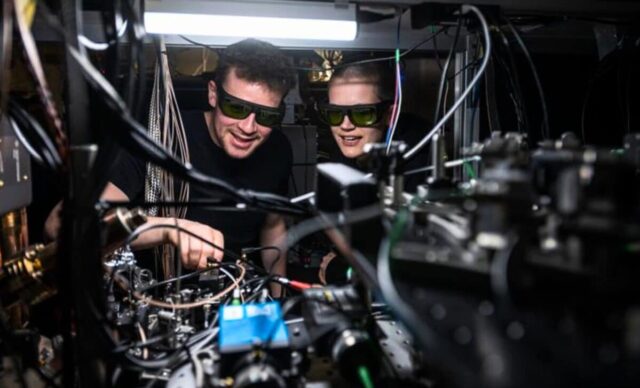
In a major milestone for quantum technology, researchers at Oxford University have successfully demonstrated the teleportation of quantum logic gates between quantum computers. This breakthrough, which involved transferring quantum information across a distance of two meters, represents a crucial step toward enabling large-scale, interconnected quantum networks.
Quantum Teleportation: A First for Logic Gates
Teleportation in quantum mechanics is not the science-fiction concept seen in movies, but rather the instantaneous transfer of quantum states between two entangled particles, regardless of distance. While quantum teleportation of individual qubits has been achieved before, this marks the first time that quantum logic gates—the fundamental building blocks of quantum computing—have been successfully teleported.
The experiment conducted at Oxford focused on transferring the quantum spin state of one system to another with remarkable accuracy, achieving an 86% fidelity rate. This means that the transferred state closely resembled the original, ensuring that the quantum information was largely preserved during teleportation. This level of precision is critical, as quantum computers rely on fragile quantum states that can easily be disturbed by external noise.
Why Is This a Big Deal?
Quantum computers hold the potential to revolutionize computing by solving problems far beyond the reach of classical machines. However, one of the biggest challenges in scaling quantum computing is enabling interactions between different quantum processors. Traditional data transmission methods introduce noise and errors that can disrupt delicate quantum states.
By teleporting logical operations between separate quantum systems, scientists have demonstrated that quantum information can be shared reliably without the need for direct physical links. This breakthrough could lead to the development of modular quantum computing, where multiple quantum processors work together seamlessly, much like nodes in a classical supercomputer.
Laying the Foundation for a Quantum Internet
The implications of this research extend far beyond computing. The successful teleportation of logic gates brings us closer to the realization of a quantum internet, where information could be transmitted securely and instantaneously across vast distances using quantum entanglement.
Unlike classical networks, which rely on traditional encryption methods, a quantum internet would provide unhackable communication through the principles of quantum mechanics. Any attempt to intercept quantum data would disturb the entangled state, immediately alerting the sender and rendering the information unreadable. Governments, financial institutions, and cybersecurity experts are keenly interested in this technology for its potential to revolutionize secure communication.
Challenges and Next Steps
While the teleportation of quantum gates is a major breakthrough, several hurdles remain before this technology becomes practical on a large scale:
- Increasing fidelity: The current 86% accuracy needs improvement to minimize information loss and errors.
- Scaling up distances: While two meters is impressive, a global quantum network would require teleportation over hundreds or even thousands of kilometers.
- Integrating with existing quantum architectures: Teleportation must work seamlessly with various types of quantum hardware, from superconducting qubits to trapped ions.
Future research will focus on refining the teleportation process, improving error correction methods, and extending the reach of quantum entanglement. If successful, these advancements could usher in an era where quantum computers communicate effortlessly, unlocking new possibilities in cryptography, artificial intelligence, materials science, and beyond.
Conclusion: A Glimpse into the Future
The teleportation of logic gates marks a pivotal moment in the journey toward fully functional quantum computing and next-generation communication networks. As researchers push the boundaries of quantum technology, we are inching closer to a future where information moves at the speed of entanglement, computing power defies classical limitations, and data security reaches unprecedented levels.



